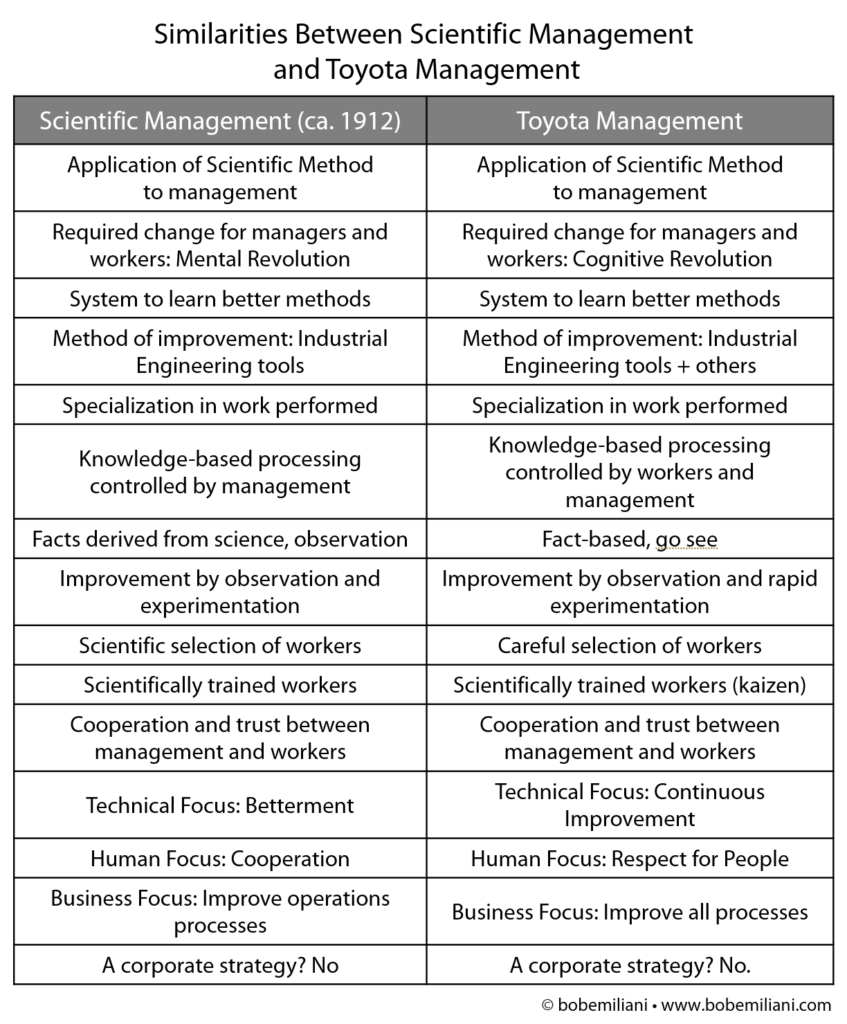Poor Frederick Winslow Taylor. Almost everyone hates him these days. Yet, just about everyone loves Taiichi Ohno. Why?
What Taylor started — the application of the scientific method to management (Scientific Management), the field of industrial engineering, and ensuring non-zero-sum outcomes for workers — Ohno-san and a small army of Toyota engineers finished. In modern times, the story of “respect for humanity” begins with progressive Scientific Management and evolves over time though the Toyota Production System.

Unfortunately, most people have been greatly influenced by faulty secondary and tertiary interpretations and descriptions of Taylor’s work written by people — mostly career academics who know nothing firsthand about business, industry, work on the shop floor, processes, time, motion, productivity, cost, quality, lead-time, or customer satisfaction. They, like most others, ignore the primary sources of information written by Taylor, as well as his colleagues Henry Gantt, Frank Gilbreth, and, perhaps most importantly, Dr. Lillian Gilbreth; not to mention Morris Cooke, C. Bertrand Thompson, Henry Farquhar, Carl Barth, Horace Drury, Harlow Person, James Dodge, Henry Kendall, Horace Hathaway, Harrington Emerson, Charles Going, Dexter Kimball, Hugo Diemer, and others whose names you have probably never heard.
Ohno-san and Toyota engineers built on the work of these men and one woman.
You also probably never heard of Frank Woollard, a pioneer in the British automotive industry who built upon the work of Henry Ford and Taylor to create a TPS-like flow production system at Morris Motors in the 1920s. Woollard’s production system featured continuous improvement and “benefit for all” — what we now call “respect for people.” Woollard perceptively said: “This principle of ‘benefit for all’ is not based on altruistic ideals – much as these are to be admired – but upon the hard facts of business efficiency.”

Ohno-san and the engineers finished what Taylor started. TPS is, in fact, a far more rigorous system for worker compliance than anything that Taylor imagined. Ohno-san and the engineers created the “full-work system” to “…raise the ratio of value-added work… [through] the total elimination of waste” to produce only what is needed (T. Ohno, Toyota Production System, 1988, pp. 59-60). In comparison, Taylor’s system was a much-improved “partial-work system” — nothing like the debilitating work system that Taylor is much criticized for having (not actually) created. The ameliorative solution that Toyota discovered was freeing workers to think and experiment with ways to improve their work, in collaboration with engineers. (Note: By the late-1910s, progressive consultants in the Scientific Management movement were seeking greater worker participation in improvement).
Taylor’s work was groundbreaking in its day and he and his colleagues were world-famous. We are fortunate that Ohno-san et al. built upon Taylor’s work and added many important improvements. But who will build upon Ohno-san’s work? What important improvements need to be made to TPS?
Either you love both Taylor and Ohno-san, or you hate both Taylor and Ohno-san. You cannot love Ohno-san and hate Taylor. Without Taylor there would be no Ohno-san to love. They are kindred travelers in the journey for improving business and the human condition. Who will join them next?
